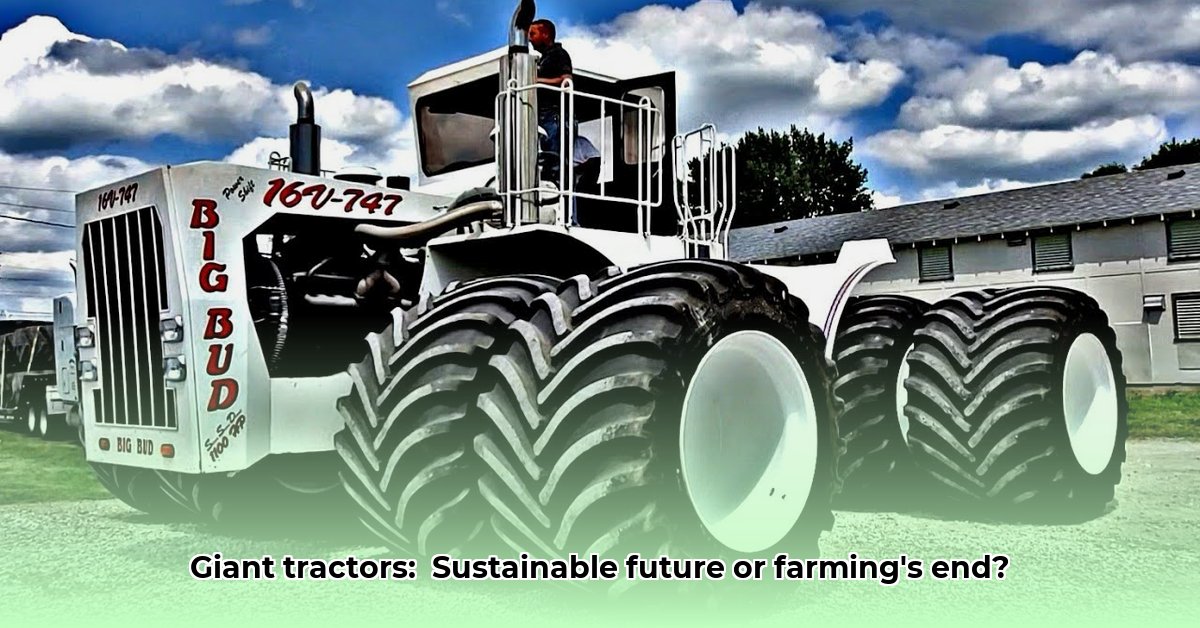
The relentless pursuit of agricultural efficiency has yielded impressive results, none more striking than the colossal farm tractors dominating modern fields. These behemoths boast horsepower rivalling small cars and fuel tanks the size of mini-vans, capable of tilling hundreds of acres daily. Yet, their environmental impact raises critical questions. Are these giants truly paving the way for a sustainable future, or are they sowing the seeds of ecological disaster? This article delves into the complex relationship between these powerful machines and the future of sustainable farming. For more on the costs involved, see tractor prices.
The Titans of the Field: Meet the Biggest Tractors Around
Imagine a machine capable of tilling hundreds of acres in a single day. This isn't science fiction; manufacturers like Case IH produce tractors with horsepower exceeding that of many automobiles. These gargantuan machines offer significant productivity boosts, translating into substantial cost savings for farmers. This efficiency, however, comes at a price – a price not always immediately apparent.
The Environmental Footprint: A Heavy Price to Pay?
The primary concern surrounding these massive tractors is their immense weight. Comparable to a fully loaded semi-truck, this weight compresses the soil, akin to squeezing a sponge dry. Compacted soil struggles to absorb water, hindering crop growth by limiting water and air access to plant roots. This leads to reduced fertility and overall productivity over time. Soil compaction also contributes to increased runoff and erosion, further harming the environment.
Fuel consumption presents another significant challenge. While large tractors dramatically reduce fieldwork time, their fuel usage is correspondingly substantial. The long-term balance between productivity gains and increased fuel consumption requires further in-depth study. Early research suggests a potential tipping point, where fuel inefficiency outweighs the benefits of speed and efficiency. These are crucial considerations for responsible agricultural practices. Do the cost savings truly counterbalance the environmental effects?
Precision Farming: A Tool for a More Sustainable Future?
Fortunately, technological advancements offer potential solutions. GPS-guided systems and automated steering minimize human error, reducing fuel waste and overlaps. Variable-rate technology allows for precise application of fertilizers and pesticides, only where needed. However, these advancements do not fully address the problem of soil compaction. The inherent weight of these machines remains a substantial environmental concern.
Finding the Right Balance: It's Not a One-Size-Fits-All Solution
Sustainable farming is not about choosing a single "perfect" tractor size. The optimal tractor selection depends on various factors, including farm size, crop type, and soil characteristics. Smaller, more fuel-efficient tractors might be ideal for smaller farms or specific tasks, while larger machines remain necessary for large-scale operations. Farmers must carefully evaluate the financial gains against the environmental implications before making a decision. Sustainability involves careful consideration and a nuanced approach.
The Future of Farming: Innovation on the Horizon
The future of sustainable farming holds promising innovations. Manufacturers are actively developing fuel-efficient engines, exploring alternative fuels such as biofuels, and investigating the potential of electric tractors. Research into lighter-weight materials and improved tire technology aims to mitigate soil compaction. The integration of artificial intelligence (AI) and advanced data analysis promises to optimize resource use and minimize environmental impact, empowering farmers to make more informed decisions.
How to Minimize Soil Compaction from Large Agricultural Tractors
Modern agricultural practices, particularly the use of large tractors, contribute significantly to soil compaction. This compaction reduces crop yields and compromises soil health. Several strategies can effectively mitigate this problem, including controlled traffic farming, tire pressure adjustments, and the utilization of cover crops. The optimal strategy depends on factors like soil type, climate, and specific crop needs. Implementing sustainable practices requires a broad approach, involving farmers, equipment manufacturers, researchers, and government agencies.
Controlled Traffic Farming (CTF): A Strategic Approach
CTF involves carefully planning and adhering to designated tractor routes throughout the growing season. By restricting heavy machinery to specific paths, the overall compacted area is minimized, preserving soil structure.
Tire Pressure Management: A Simple Yet Powerful Tool
Adjusting tire pressure can significantly influence soil compaction. Lowering tire pressure increases the contact area with the soil, distributing weight more evenly and minimizing concentrated pressure points. Regular pressure adjustments are vital for dealing with varying soil conditions.
Cover Cropping: Nature's Solution
Cover crops, planted between commercial crops, act as natural soil conditioners. Their root systems penetrate and loosen compacted layers, improving soil structure and aeration. They also help prevent erosion.
Precision Agriculture Technologies: Harnessing Technology's Potential
Precision agriculture utilizes GPS technology and sensor data to optimize equipment functions, including variable-rate application of fertilizers and pesticides. This minimizes the need for multiple passes with heavy equipment, reducing soil disturbance.
The Path Forward: A Holistic Approach
Minimizing soil compaction is not merely about boosting immediate yields; it is about long-term soil health and sustainability. Achieving this necessitates a unified effort involving farmers adopting sustainable practices; manufacturers producing more efficient and lighter equipment; researchers continually seeking novel solutions and supportive government policies. The journey towards sustainable agriculture is an ongoing process of learning, adapting, and innovating. Striking the ideal balance between productivity and environmental responsibility presents a formidable challenge, but one that demands our unwavering commitment.